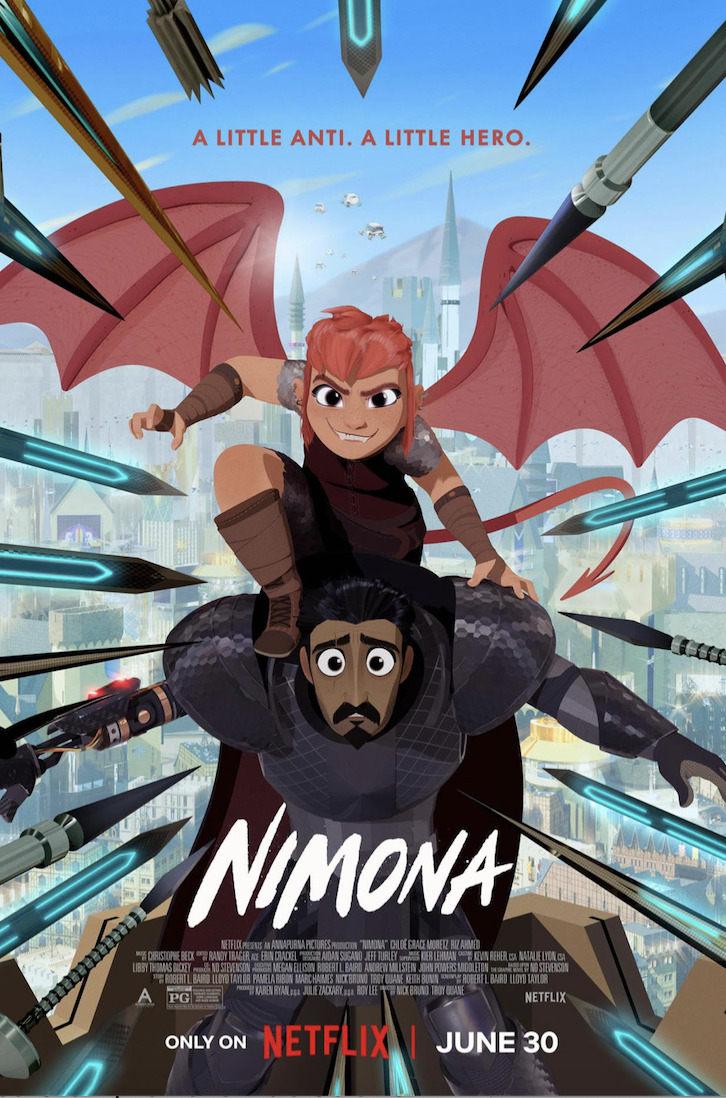
Synopsis : When Ballister Boldheart (Riz Ahmed), a knight in a futuristic medieval world, is framed for a crime he didn’t commit, the only one who can help him prove his innocence is Nimona (Chloë Grace Moretz), a mischievous teen with a taste for mayhem — who also happens to be a shapeshifting creature Ballister has been trained to destroy. But with the entire kingdom out to get him, Nimona’s the best (or technically the only) sidekick Ballister can hope for. And as the lines between heroes, villains, and monsters start to blur, the two of them set out to wreak serious havoc — for Ballister to clear his name once and for all, and for Nimona to… just wreak serious havoc.
Rating: PG (Violence and Action|Rude Humor|Thematic Elements|Some Language)
Genre: Action, Adventure, Animation
Original Language: English
Director: Nik Bruno, Troy Quane
Producer: Roy Lee, Karen Ann Ryan, Jule Zackary
Writer: Robert L. Baird, Lloyd Taylor
Release Date (Theaters): Limited
Release Date (Streaming):
Runtime:
Distributor: Netflix
Production Co: Double Negative (DNEG), Toei Animation, Sony Pictures Animation, Vertigo Entertainment, Annapurna Pictures, DAMN! Show Productions
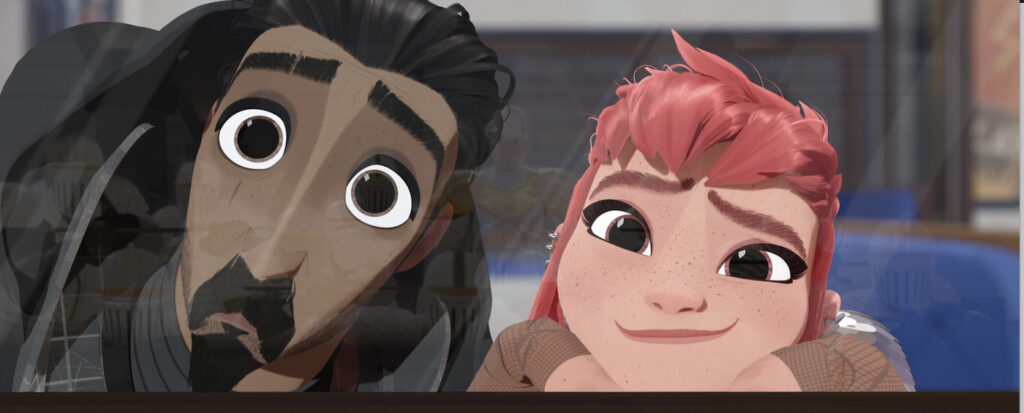
Q&A with Producers karen Ann Ryan, Julie Zackary Directors Nick Bruno & Troy Quane, Creator ND Stevenson, Moderator Chris Wedge.
Q : I watched a movie. It hits you hard. I really want to talk about how it got here. To me, the movie itself is about shape shifting. It finally appeared after like 10 years, and here it is. I guess I’ll start with you ND, I’d like to know for the benefit of people that wonder how the hell does something like this get made? For me, after decades of doing this [kind of thing], it’s still a mystery; it really is. Describe for us, if you can, what was going on with you and who you were like before you put a pencil on paper or not?
ND Stevenson: When I started to draw it, I was 19 and in college, an art school. As many 19 year olds are, I was going through the transition from being a kid to being an adult and figuring out what that meant for me. It wasn’t easy and it wasn’t pretty. I felt very lonely and just adrift in so many ways. Nimona sort of popped up from my sketchbook and was this character that came out and was everything I wanted to be. I wanted to be able to change myself, I always loved to change.
I wanted to be that, but she also was so short, she knew exactly who she was and I didn’t at that time and that’s what I wanted. This character was really something that I just liked. She healed some part of me. She also had her heart, had all this pain and had this loneliness. She was seeking acceptance, which I was too, but I had no idea being here. This was never on the radar. This is not something that I expected.
I realized along the way that a lot of people related to this character. I was not as alone as I thought I was. This character really connected with a lot of people, with everyone here. Each had their own way of relating to her. I thought it was just my struggle. Me being alone, I was not 11 anymore. And I felt, seeing the response to this movie, of being a part of this crew making this movie and bringing these things to the finish line. It just made me realize that this character is really universal and so many people saw themselves in her — it feels very healing.
Q : It was you sharing it online, then people were reacting and that helped you. It helped you find the setting and the story, like you knew where, out of nothing, it just came from.
ND Stevenson: I also was finding myself. I was trying to express my feelings, didn’t know how and thought no one really understood. Then with finding comics, I realized that people were starting to understand more and I would put something out and people would understand the feelings that I’ve been trying to express. So with the comic, it came from this character, this history book. I was doing a comic that I was putting out twice a week [online].
Not expecting very much, I thought I would [build] a crowd and turn it into a self-published comic. When it became a graphic novel with Harper Collins, I was just like, “Whoa, this is taking on a life much bigger than I ever thought it would be.” Then from there, it was optioned for an animated feature and I was like, “Wow, ok, like this is happening.” But even then, over seven years since, I was only seeing it on screen now and seeing everything — I liked it. I never predicted any of this, not in a million years. I was just trying to figure out how to tell a story that meant something to me and realizing that it meant something to a lot of people.
Q : This show is as improbable as it gets in my opinion. Any one of the obstacles that it came across, knocks movies out every day. First thing is that it was optioned by a major studio, that was the first strike against it — it goes into a slate of over 100 films and development options. That it rose above that is one thing. It went through, I think I counted, maybe five [studios]. Yes, it went through the sale of one major in the studio to another.
It went through the pandemic and survived all of the apprehensions about how people were going to come and watch movies. Netflix people then watched this movie and loved it. It rose out of the building of an animation studio. and here it is. That’s why It’s amazing. It’s outside. The strength of your idea led to this thing that it seemed to have pushed it through. Otherwise it’s just the movie Gods and nobody else. What do we do? Cruel and hard as God? Let’s talk about sacrifice. I will direct questions to the producers and directors. OK, tell me what your first exposure to Nimona was in your life?
Nick Bruno: The first exposure for me was reading the graphic novel. I didn’t see the webcomic but had known we were doing it at Blue Sky. I saw everyone was super-excited. I read a graphic novel. It was all inside of the very first comic I ever read.
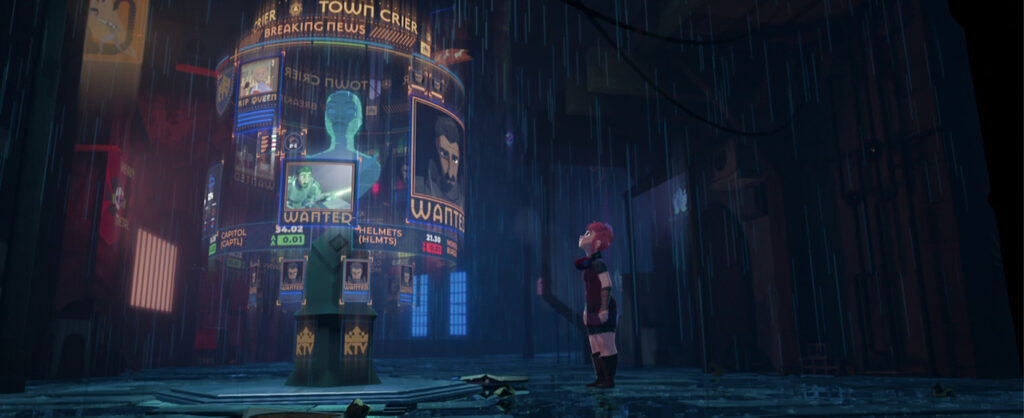
Q : Yes. Right. Let’s hear from you. You should be brushing that off — keep that stuff to yourself [laughter].
ND Stevenson: To be fair.
Nick Bruno: I don’t know how to read but this one had pictures so I understood it. Honest to God I loved the character from the very first. Nimona [is] this little ball of terror just knocking on the door and saying, “I’m your psyche.” I was just instantly liked that [and thought], “What the fuck?” That’s part of my language. I know there’s kids here [who] don’t say fuck.
But it really was this that I’ve never seen anything like it — it was so funny, so different. You’re following characters that you’ve never seen/felt before. Everything that you couldn’t predict not a single thing that was happening and I loved it. Somewhere in the middle of it, I was like, “Holy shit. This is really heavy.” It was so amazing and I just felt super-connected to reading it. I felt like it was something that comes along and it’s a gift — it really was a gift.
Troy Quane: I just realized, “He actually loves this, I gotta check it out and I think I heard about four or five strips of this.” They were really cool. I felt it for like two weeks and then life took over and so I went, “Wait, there’s a whole book and it was amazing.” I came back in and discovered it. Like I said, it has such a palpable energy and excitement. I want to say I wasn’t completely jealous when we were working on another movie and everyone was just talking about this other one.
But once we started to pull our heads into some of these rooms, you’re like, “Oh shit. This is amazing. There’s just something [special] in the character.” Everything was unexpected and fun. I think the word is “unapologetic.” She’s just so selfish, surely unapologetic.
I loved it because I have two teenagers and anyone who has teenagers may understand that they play a little bit more every day; there was something so great about this character who had rough edges, who was in one way, really funny and appealing. Sometimes you can feel the pain, anger, frustration and the confusion — lashing out with that. I just loved the messiness of it. It just made it feel so real and it so really appealed to humanity. I think we all felt so.
Q : It did eventually get into production at Blue Sky. Karen, describe your first contact with Nimona?
Karen Ann Ryan: My first contact with Nimona was when I was actually interviewing at Blue Sky and everyone said, “Yeah, we’ve got “Nimona.” It’s a great production.” I’m like, “What’s Nimona?” So I picked up the graphic novel and read it. I’m like, “This is amazing, it’s so great. This is going to be so much fun.”
But coming to the studio and seeing the buzz on the floor, the collective participation and the story notes — I saw everybody being able to contribute to the story and everybody really understanding that they were part of it. We were just making a movie but I had never seen anything like it. I felt so lucky to have been at the studio where the entire [production house] was involved. Everybody was helping out on this, not just by making the images, but by relating to the stories and participating in notes. It was incredible.
Julie Zackary: I’m the old timer on the stage after the two of us. I read the comic and loved it. I heard that it was happening at Blue Sky and there was an opportunity for me to go [there]. I went and at the time they told me, “Oh, it will be about an 18 month project. It’s going to be pretty quick. I was like, OK.” And that was over five years ago.
Troy Quane: They told us the same thing.
Julie Zackary: Yeah, it’s an incredibly special project. The character herself is what carried all of us through this and then showing up at a Blue Sky in a different life and era of this movie. I had the privilege of watching all of these people open up to it, connect to it and become part of it. It changed the movie. It changed all of us and it’s still very surreal to me that we’re here and to share it with everybody.
Q : I’ll say. I was around while we were doing this. I was one of the people in those rooms, scratching my head while the rest of us were about how do you put your story [referring to ND} on the screen. Let’s talk a little bit about that process. I had read the comic book, a AAA graphic novel. I read your novel a number of times trying to help figure out what we were doing. I read it again today. I have to say that the tone of this thing among us now — it’s in there and for the world it’s here, but we had no way to make it into a movie.
We really struggled. That’s fair to say. Can we talk a little bit about that? Anyone’s welcome to chime in about how it got from [print to screen]. This is true for animation all the time. You can draw storyboards and cut them together and you watch it and see if there’s a movie there. I’m sure you [all] saw some of this, the patient was on the table but what has that meant to the process. I guess the fortitude of the people working on it got to this point because in my humble opinion, it’s the best movie version of your book that you can, you can hope for.
ND Stevenson: I agree. I’m the creator of the original comic. I’m here on this stage glowing with how much I love this movie. Like that, I’m going to be the number one type of critic of this movie. And I’m like there are so many versions of this movie and there are so many times when people are like, how do we relate to Nimona? She’s just so out there, she’s like, in their face but she’s a teen girl. I’m not a teen girl and it’s like, “How do we even explain to you why this character matters?”
At a certain point, it was really like seeing the refocusing on her character — of seeing a lot of people who saw themselves in her, whether or not they shared the experiences she has — she is universal. The second that it started to be like all of us, that’s when the movie started coming through. It wasn’t trying to find a version of her making her likable and cute and a character that everyone’s going to understand. No, It’s like she’s herself, she’s in your face. She’s scary. She’s weird. She’s all over the place. That’s her and that’s like us. There’s a part of us. All of us are… We have to hide but she doesn’t hide — and that’s what this movie became. It was these people who brought her through.
Troy Quane: Yes. But it still was hard. I mean, you read the graphic novel. There’s so much amazing stuff in there — that said this is such an iterative art form. You throw the story up and work on it. It is funny; the story part of your job is to find 1000 ways that don’t work and, finally, what is the way it works. Nick and I sort of had a chance to come in with fresh eyes and a different perspective and really lean on some of that exploration. It’s exactly what he was saying. We both knew that we fell in love with it.
No one knew she was going to be the end point of the story. We’ve seen so many versions where it was this or it was about eating villains or crime — but it really was just about this character. Once we decided on that and zeroed in on that, there were a lot of fun, amazing elements in the graphic novel that we related to, then we blamed all the wrong paths taken because there’s so much amazing material in there. But once you know what the character is and what “she” was trying to say, you know how to build other characters around it and where to put aside some of those other elements for the sequel [Applause].
Julie Zackary: I know there’s a lot of filmmakers in this room and film students, people who are on their own creative journeys here. There was a moment in this film where we struggled and went down some really ridiculous roads trying to figure out the story that was going to take shape here. But, talk about research — trips you take to locations, you go to different places and study things, you look at the past and ask, “Can we do that with this movie.” There’s no medieval future to go and check out.
But the research that we did and what unlocked the story, what we were doing, was opening up the conversation with people who were in this room. They came into the studio, and we asked people to share with us how they were connected to the story and focused it back on them. We said this before, but that really was the key. Then people started sharing their own experiences with us. That’s when the story got back on the track and we saw what we could do. Ask people for help, ask how they feel and seek opinions that are different from your own.
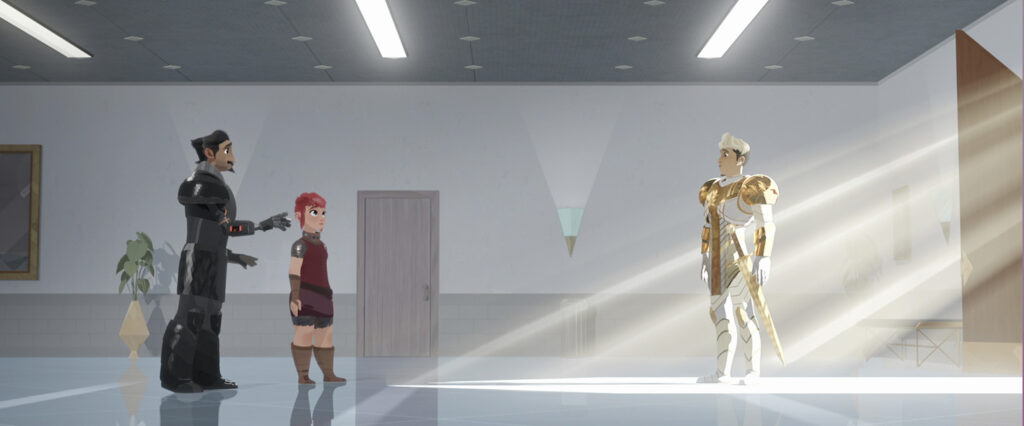
Q : Nick, was there any one moment where you felt you understood the movie — when it broke through to you?
Nick Bruno: I always had the answers to everything. I’m glad you asked me this question [laughs]. I remember when I was a little kid… How many little kids are out here — when I say little kids, I mean, grown-ass kids — sometimes you’re doing a drawing and you’re just like, “This sucks. I can’t draw, right?” I remember an art teacher once said, “Well, what are you trying to draw? Think about it before you’re trying to draw.”
What great advice. And that’s what Karen did at one point, she said to the entire studio of all these amazing artists — “What are you trying to draw? Why is this important to you?” And it started them opening it up for lunch. People just started kicking open the doors and telling their stories about why “Nimona” is important to them. At this time, Troy and I were on “Spies in the Skies.” Nobody has seen it.
Q : The movie is Disney +.
Nick Bruno: The lunches that Karen had, started kicking open a conversation — more and more people started showing up and we started seeing what they liked. We really started seeing people very passionate about the story. It’s a universal story, right? We’ve all felt misunderstood, but it became very clear that there’s a kingdom of people who feel more passionate about that and feel they’ve been in the shadows more than most. Those were the members of the LGBTQ plus within our studio.
When they’re telling these stories, they’re heartbreaking and profound ones. They’re also happy stories and contentious stories. There’s everything and I just sat there listening and we were just like, “Why are we not doing that?” That is what “Nimona” is when I read the graphic novel. It’s staring you in the face. It’s like Nimona is this real entity, this real spirit that’s saying fucking do this. It’s going to be all right again. We started being in those rooms and started trying to help out by listening to these stories. Any time it started going in another direction, like what if we take them on a cruise? It was like, “Shut up.”
Julie Zackary: There was a cruise ship.
Nick Bruno: Something crazy enough just to be true. That’s how desperate we were and how bad our drawings were. That started the momentum — and real conversations — cause we were trying to make a cool action movie. But most of this movie is just two knuckleheads on the ride to an action movie, talking about their differences. We are two knuckleheads — the knights are really dumb — and that’s really our role.
ND Stevenson: This is what you started doing, you were realizing it and you got to come back and punch me in the face, feeling that I didn’t know was happening at the time [laughs].
Troy Quane: The great thing is, that once you’ve discovered that, it feeds into everything, right? It feeds into all the choices you’re making, what making a future means. It’s just really cool. When you understand that meaning, that’s a culture that’s moved forward in time with your thinking frozen in space. Everything takes on a different meaning and then you feel more confident.
Nick Bruno: Then you go outside… We don’t have flying cars but we have all this technology and yet so many of our minds are locked in the past — that’s something that needs to be faced.
Q : I really think it’s a good movie, a great movie. Thank you. Is that you really mind that thematic stuff and the character and all the emotions this crowd was in. You did all the things you’re supposed to do. It’s funny. I wasn’t involved for the last 18 months of this thing, but you feel this movie in so many places because the storytelling is so well focused and you’re getting down to the bottom of this stuff and you really feel it. ND, if you can, would you describe your own reaction to the movie.
ND Stevenson: This has been such a journey. There have been moments where it was like, “OK, this movie is definitely not getting made. I have to be ok with that or maybe the movie will get made and I won’t recognize it or it’s not the story I intended. I have to be OK with that too.” In that version, I’m not on this stage.
I told the story I told and now this is going to be the same, the fact that I’m here and I get to share this with y’all like we’ve been through so much together. That was something that was not always guaranteed. And to see this movie, there’s so many times you just open your hand and let it be what it’s going to be. It was just on my side. I was always trying to bring out Nimona, to make sure that Nimona stayed at the center of it. That became my fight.
When it started coming back, when it started being a conversation like it’s a story that in many ways is familiar and turns it on its head — she’s the catalyst. She’s the version that makes this something totally new. When it started coming back and I started seeing her spirit reflected back, that was a conversation that we were having together. Everything just started to feel like this was a movie which is different from the book. It is, and so like I am, there are so many things that I’ve seen, so many times like today, that knocked me on my ass — like all these illusions that I wasn’t expecting me to feel today.
It still catches me off-guard. That’s the movie. There are so many things to see in it. I’m just being carried along for the ride at this point. Nimona’s spirit is carrying us forward. I’m watching it happen and being affected by that too with everyone else. There’s a story I didn’t know I was telling and now there’s even more to that story that is being told in front of my eyes. In fact, it’s being brought out by really great people who are just doing something really incredible and amazing. I’m just really honored. Here we go.
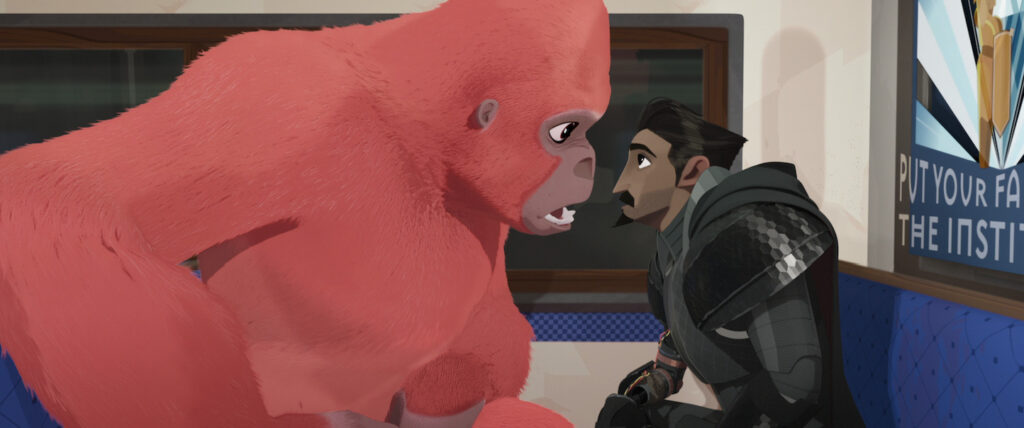
Check out more of Nobuhiro’s articles.
Here’s the Trailer of the film.

